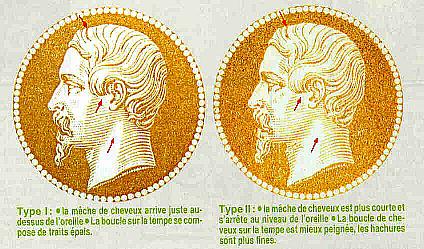The 10 centimes "EMPIRE" NOT NOTCH

|  |
Type I |
Type II |

|  |
Type I |
Type II |
 |
 |
 |
 |
 |
| Essai de couleur verte | |
Essai de couleur bleu | Coussinet d'impression |
 |
 |
| |
Type II oblitéré ES2 |
Louis Napoléon BONAPARTE President of the Republic,
after the coup d'état of December 2, 1851 became Emperor following the
plebiscite of November 21, 1852.
Jean-Jacques BARRE was charged
to modify the legend of French stamps on January 8, 1853. It is the effigy
of the Emperor NAPOLEON III with the legend "EMPIRE FRANC".
The postage stamp 10 C EMPIRE not
notched was emitted in December 1853, there are two types and in each type
several nuances of color. It is the postage stamp used for the local correspondences
(local simple letter). The law of May 10, 1853 created " the premium
with stamping ", law executory on July 1, 1854. Letters freed from
Paris in Paris paying only 10 C whereas the not freed letters were taxed
at 15 C.
During all its utilization service
time, it was also useful for stamping of the simple
letter with 20C and the complements of stamping for the
various destinations. Stamping mixed are
very required especially the remote countries.
The first emission, the normal
color is brown: type 1.
The second emission carried out
Desire-Albert BARRE, wire of J&J. BARRE. This emission begins in October
1860, the normal color is browned: type 2.

All the stamps are printed on paper tinted in the paste of the diminutive color of the color of the stamp.
In the nomenclature of the catalogues it is N°13 Y&T, Cérès and N°9 in the Marianne catalogue
The various colors are for type 1: bistre, bistre-yellow clair/jaunâtre, yellow-lemon/jaunâtre, bistre-jaune/jaunâtre, bistre-orangé/jaunâtre, bistre-roux/blanchâtre, bistre-terne/blanchâtre imp.défect., yellow lemon-tern/blanchâtre imp.défect., bistre-foncé/blanchâtre, bistre-brun/blanchâtre.
The various colors are for type 2: bistre, bistre-foncé/blanchâtre, bistre-clair;/blanchâtre, brown-foncé/blanchâtre.The normal cancellation are for Paris: rhombus with Roman letter or stick, black star, the grid without end, the seal on date, roller large points.
Exceptional cancellation: the grid
For the province : small figure (PC), then large figure (GC) in 1862.
For the offices abroad : small figure (PC)
For the postal agencies embarked on the steamers of the Mediterranean: the anchorA special with drawing was carried out with an aim of constituting collections of administration. For 10 C it is with type 2.
Since 1854, houses specialized to avoid the use of the scissors invented processes to separate the stamps, it are that one names prickings: prickings of Knew (paper of Paris) Official statement bored in lines bored out of saw pricking of Clamecy (teeth in lengthened points) pricking of Cosne (teeth in triangle)
It was replaced by 10 C WORSENS notched in August 1862.